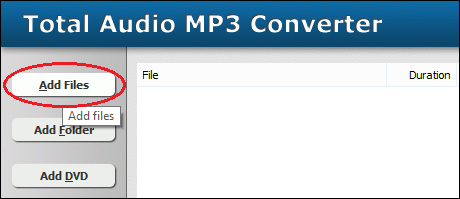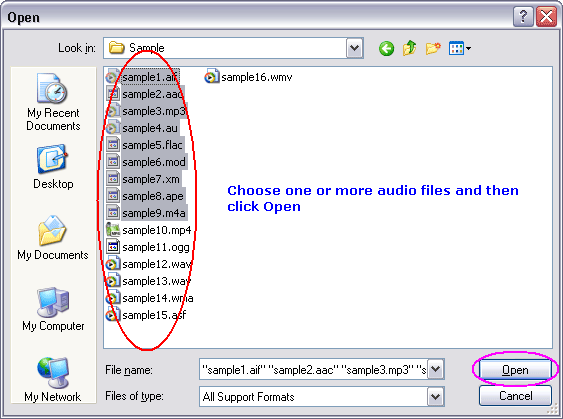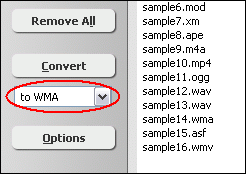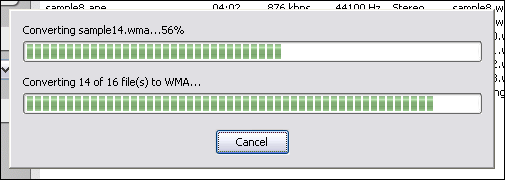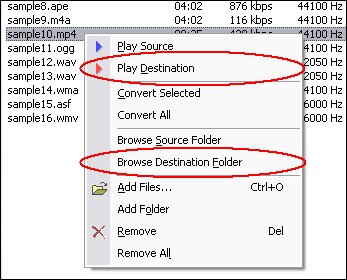FLIC to WMAConvert FLIC to WMA, FLIC to WMA Converter |
 |
| Home | Getting Started | Download | Buy Now! | Screen Shots | FAQ | Support | Contact |
FLIC to WMA Converter converts FLIC to WMA. The software is an ALL-IN-ONE audio converter that supports more than 100 audio and video files. FLIC to WMA Converter supports batch conversion and is full compatible with Vista and Windows 7.
What is FLIC / FLI / FLC? The FLC is a successor to FLI. FLC can store images of variable size, and allows a palette of 256 colors (although the palette can be changed from line to line to give more colors per frame). FLC supports a variable frame rate specified in frames a fixed frame rate specified in milliseconds per frame, and maintains information about the original aspect ratio. In theory, all FLC animations must loop, but in practice this requirement is often ignored. The image data in FLC files is compressed using a Run-length compression scheme. This is suitable for animations, but is inappropriate for videos or dithered images. As mentioned, the FLC format is a successor to (and close cousin of), the older FLI format. Difference between FLI and FLC, as too often they are taken for different names of one format. In fact those files that have extension .fli are of older format. The new format was not limited to 320x200 resolution and had better compression. The files of the new format got the extension .flc. There is also FLX files which are a slight variation on the standard FLC format. As both names become widespread and refer to the same variations of the same format we use FLI/FLC when describing the formats. FLI/FLC format appeared in 1993 as an animation format (developed by Autodesk, Inc). FLI/FLC format is widely used for scientific cartoon type movies (animated graphs, etc.). FLI/FLC movies are more deairable than MPEG as 640x480 movies can be played back at reasonable speeds on X11 workstations, PCs and Mac. The codec uses RGB colorspace: paletted RGB8, RGB15, RGB16, RGB24. RGB8 is tightly coupled with the VGA mode 0x13. Compression methods are RLE-based. There are many variations of flic container, the most common are the original FLI from Autodesk Animator and the extended FLC from Autodesk Animator Pro.Standard FLIC files are video-only. However, various deviations also include audio. The file format is chunk-based. FLIC video frames can be stored inside of an AVI file. In this case, a 256-entry 32-bit RGB palette is stored in the AVI header per the usual method for doing so. FLIC video frames can be stored inside of an Apple QuickTime file. In this case, a 256-entry 32-bit RGB palette is stored in the video atom's stsd atom per the usual method for doing so. What is WMA? A WMA file is in most circumstances encapsulated, or contained, in the Advanced Systems Format (ASF) container format, featuring a single audio track in one of following codecs: WMA, WMA Pro, WMA Lossless, or WMA Voice. These codecs are technically distinct and mutually incompatible. The ASF container format specifies how metadata about the file is to be encoded, similar to the ID3 tags used by MP3 files. Metadata may include song name, track number, artist name, and also audio normalization values. FLIC to WMA Related Topics: DXA to WMA, GSM to WMA, GXF to WMA, MJ2 to WMA, MLP to WMA, MTV to WMA, QCP to WMA, ROQ to WMA, RPL to WMA, VQF to WMA, W64 to WMA, WAVE64 to WMA, XA to WMA, EVOB to WMA, H263 to WMA, H264 to WMA, HDTV to WMA, MKA to WMA, MMF to WMA, MP1 to WMA, MPA to WMA, OGA to WMA, OGM to WMA, OGV to WMA, OGX to WMA, VCD to WMA, VOC to WMA, WM to WMA, ADX to WMA, AIFF to WMA, APE to WMA, M4V to WMA, MO3 to WMA, MOD to WMA, TTA to WMA, UMX to WMA, WAV to WMA, WMA to WAV, Resample WMA
|
| Home | Getting Started | Download | Buy Now! | Screen Shots | FAQ | Support | Contact | Links |
| Copyright © 2007-2014 Hoo Technologies All rights reserved. Privacy Policy |
